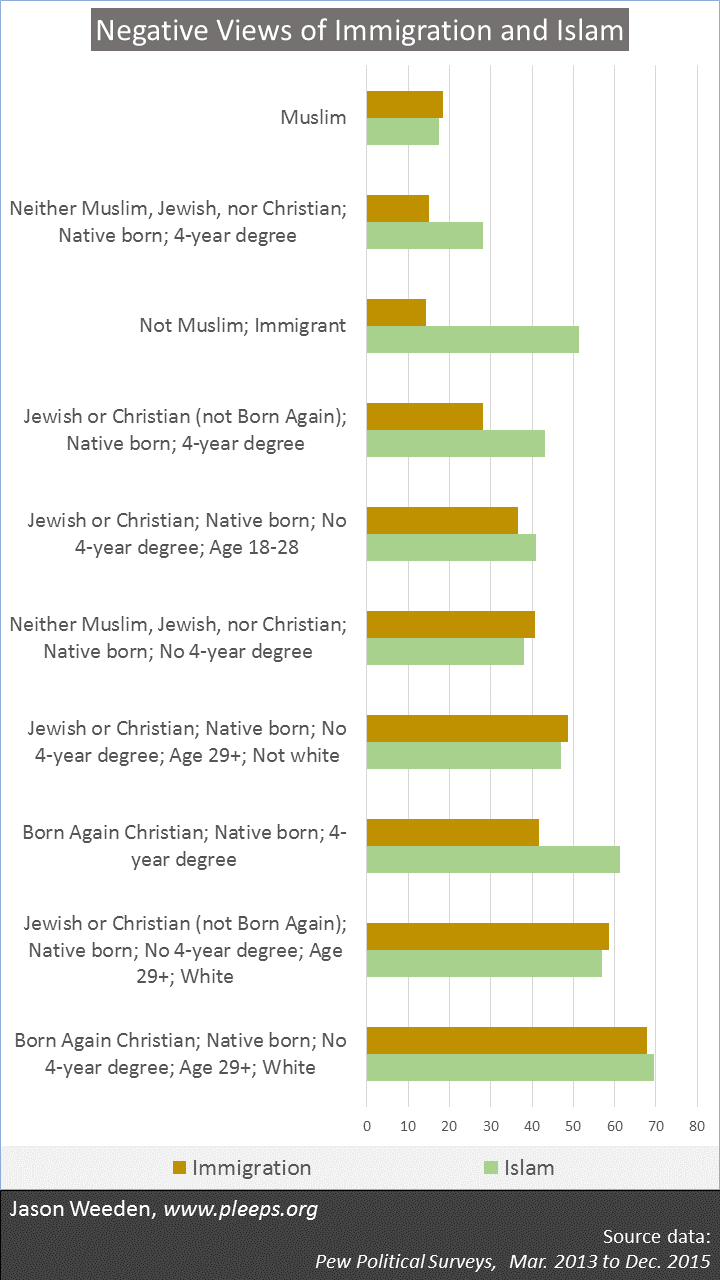People talk about dog whistles in politics, but recently the whistles have been replaced with fox-hunting trumpets. Donald Trump’s small horns call Fox-hunters to the chase with bleats and tweets of marauding immigrants and malevolent Muslims.
What kinds of folks are likely to find these positions appealing or not? Here, I look at the demographic predictors of two opinion items that have been asked in some of Pew Research Center’s political surveys (available online). One item measures opinions on whether immigrants strengthen or are a burden on the U.S., and the other on whether Islam is more likely than other religions to encourage violence. Here are the results of my analysis, with the fuller explanation down below.
 (Technical note: The percentages in the chart combine those who selected the negative response option plus half of those who declined to choose an option.)
(Technical note: The percentages in the chart combine those who selected the negative response option plus half of those who declined to choose an option.)
To find the demographic splits in the items on immigration and Islam, I made the a priori choice to first split out Muslims and then non-Muslim immigrants. Then I started splitting the sub-groups, finding the biggest demographic predictor in the biggest remaining subgroup, making a further split, and repeating that process until I arrived at the 10 groups shown in the chart. The groups are ordered from the most positive combined views on immigration and Islam up top to the most negative views at the bottom.
Unsurprisingly, Muslims (the first group on the chart) have the least negative views on Islam. They’re also really positive about immigration on average, no doubt related to the fact that lots are from immigrant families. Take the exact numbers on Muslims with a grain of salt, though, as they’re based on a really small sub-sample (Muslims are only around 1% of the U.S. population). Also unsurprisingly, non-Muslim immigrants (third on the chart) don’t often have negative views on immigration, though, on the whole, they’re neither more nor less negative on Islam than native-born non-Muslims.
Beyond Muslims and immigrants, the demographic group with the least negative views on immigration and Islam are our old friends that I discussed in earlier posts this week—people who aren’t Christian (and, in this case, also aren’t Jewish or Muslim) and who have 4-year college degrees (second on the chart). As we’ve seen, these folks are often pretty consistently liberal. Here, they’re more favorable about Islam than any group but Muslims, and about as pro-immigration as immigrants themselves. Golly.
The most negative views involve (the last group on the chart) white born-again/evangelical Christians who are ages 29+ and who don’t have college degrees. Around 70% think Islam is an especially violent religion and close to the same percentage think that immigrants are a burden on the country. Second from the bottom are non-young and non-degreed Jews and non-evangelical Christians (including lots of Catholics, mainstream Protestants, etc.), where negative views are held by 55% to 60%.
The other groups are somewhere in between. In general, more negative views are held by those with less education, evangelical Christians, middle-aged and older folks, and whites.
Shifting Party Coalitions
Do these issues provide a road-map to Trump voters—less-educated, evangelical, older whites? Well, it really is quite close to Trump’s sweet-spot in election polls so far. But in thinking through whether those with positive/negative views on immigrants and Islam are likely to oppose/support Trump, one needs to keep in mind that there are other key issues at stake in the race. For example, lots of native-born Black Christians have negative views on immigrants and Islam, but very few are going to be convinced to vote for Trump—the Democratic party represents other positions (particularly on race and poverty) that they tend to care more about. (Similarly, lots of churchgoing African Americans are pro-life, yet the overwhelming majority still vote for Democrats.) There are also plenty of pro-immigration Republicans who will end up voting for Trump on the gamble that he (more than Clinton) will advance their preferences regarding tax-and-spend policies or Supreme Court appointments.
But we are seeing a subtle shift in the party coalitions. In fact, demographic/issue shifts in the parties are happening pretty much all the time. This latest shift is in large part an extension of previous ones, as Republicans attracted white religious conservatives in the 1980s followed by anti-immigrant conservatives in the 1990s and 2000s. In line with these shifts, the center of educational gravity within the Republican coalition has been sinking—something that has created increased space for discriminatory views within that party.
Kurzban and I mentioned all this in The Hidden Agenda of the Political Mind when covering the core demographic group in the Republican coalition—white, heterosexual, Christian, churchgoing men with higher levels of education (or “human capital”) and income—a group we referred to as “Boehners” (named after the former Speaker of the House). There, we wrote (p. 169): “Indeed, if Boehners with the highest levels of human capital continue to leak into the Democratic coalition, as they have in the past few decades, one can only wonder what other effects this might have. … Would their absence from the Republican party lead to increased Republican conservatism on group-based barriers? Only time will tell.”
It hasn’t been very long since we wrote those words, and—with the new Republican standard-bearer bumptiously trumpeting his calls for big, beautiful barriers—time already seems to be telling.
